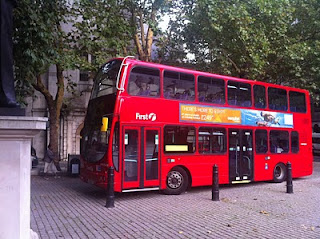 |
| Mayor Boris Johnson drives the first NBfL prototype bus out of the factory |
Work on this vehicle had been at full speed to achieve completion. The finished article was well worth the effort and everyone commented on the exceptional high quality, attention to detail, and extremely good environmental benefits of this new vehicle.
The Engineering Test vehicle has already amassed several thousand miles at Millbrook Testing Ground. We know its fuel consumption is better than predicted and its emissions rather lower. These results are hugely encouraging.
Detractors accuse the Mayor of a vanity project but in many cases they are the same people who caused TfL and its predecessors to acquire more standard vehicles which when subjected to London conditions cost significant sums of public money in engineering downtime and premature retirement.
The design will always be a matter of taste. What is certain is that the high quality of the build and great attention to detail. What will matter is that the passengers find this vehicle attractive and comfortable, and the operators find it economic to use. So far most people who have seen it are hugely impressed by its looks and ease of use.
So important was today's event that it was attended by many stakeholders including, the Secretary of State for Northern Ireland, MPs, MLAs, and the national press.
A video clip of the bus emerging from the factory is as http://youtu.be/gk_2jEtaf9U
What next? The bus will be in London during December. There will be a launch marking its arrival here in Central London. After that after further trials, formalities and training, it will enter service with Arriva in the New Year. The other seven prototypes, all in build at Wrights, will join it progressively during the first few months of 2012.
Yes I did get to drive it and as was the case with the Millbrook vehicle earlier this year it has a superb turning circle, is quiet, positive, and a very pleasurable driving experience. As a passenger the moquette seats are more traditional, comfortable and easy to use. The new wireless bell pushes mean we can have more of them and save miles of wiring down every hand pole. Inside the use of maroon and Treadmaster flooring are more than a nod to the Routemaster which, despite the media's insistence, it is not designed to replace!
So not long now until the first vehicle arrives in London, and Londoners see it for the first time for real. I think you will like it!
.....







